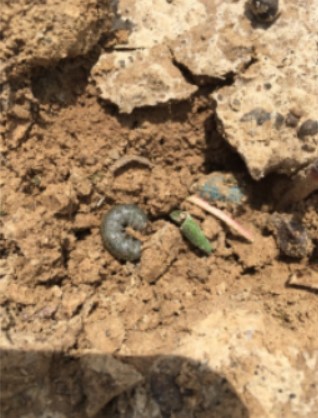
I am receiving several phone calls concerning worms in mesquite trees eating the leaves. Most are reporting black worms although a few indicate seeing light green immature worms. So far, most reports are coming from the western side of Brown County. I do recommend landowners scout your pastures and look for defoliated mesquite trees. I have personally seen some in the northern part of the county.
Usually, a defoliated mesquite tree is of little concern. However, if the mesquite tree serves as a yard tree for shade, then tree health is a concern. Also, it is almost time to aerially spray mesquite trees and if the trees do not have adequate healthy leaves, then aerial herbicide application is not recommended.
Mesquite cutworms climbing cutworms. They are usually most severe later in the summer and they usually only defoliate mesquite trees.
There are several species of cutworm that may be encountered in Texas. Adults are typical “miller” type moths from the family Noctuidae. They are common moths found around porch lights. The moths are gray or brownish in appearance, although the hind wings are light gray or silverish in appearance. Their wingspans are 1 to 2 inches. The larvae are dingy, grayish-black and smooth-skinned and may reach 2 inches in length. The larvae are primarily nocturnal and will hide under plant debris and within soil cracks and crevasses during the day. When disturbed the larvae of most species will curl up into a C-shape.
There are four major groups of cutworms based on habitat and feeding behavior:
1) subterranean cutworms, such as the pale western cutworm that feed almost entirely below the soil surface on roots and underground stems;
2) tunnel dwellers such as the black cutworm which cuts a small, tender plant at the soil surface, pulls it into the tunnel and devours the plant;
3) surface feeders such as the granulate cutworm and the army cutworm which may cut seedling plants off at the surface or feed upon leaves of older plants;
and
4) climbing cutworms such as the variegated, dingy, and mesquite cutworms, may cut seedling plants and may also feed on foliage and flower buds.
Most significant plant injury from cutworms is associated with 3rd instar or larger larvae. All regions of Texas may encounter cutworms of one or more types of cutworms.
Habitat & Hosts
Cutworms are generalist and can be found feeding on a wide variety of plants. They are considered economic pests of corn, cotton, sorghum, vegetables, and turf. Most damage occurs in the spring during crop establishment, where they can clip seedling plants off at the soil surface, resulting in poor stands. Infestations are most common in crops where thick cover crops or weeds exist at or within a few weeks before crop emergence. Cutworms are most evident when there are skips or sections of rows where all plants are missing and cut plants can be seen laying upon the soil or partially buried. Some species, such as the mesquite cutworm, are usually most severe in July and August. In turf, cutworms may hide in aeration holes and clip nearby grass or burrow under the turf resulting in “ball mark” appearing spots. They are common in flower beds with thick spring flower growth, such as with petunias, and may be observed dispersing from areas where bedding cover and mulch is disturbed. Mesquite cutworms are occasionally major defoliators of mesquite in Texas.
